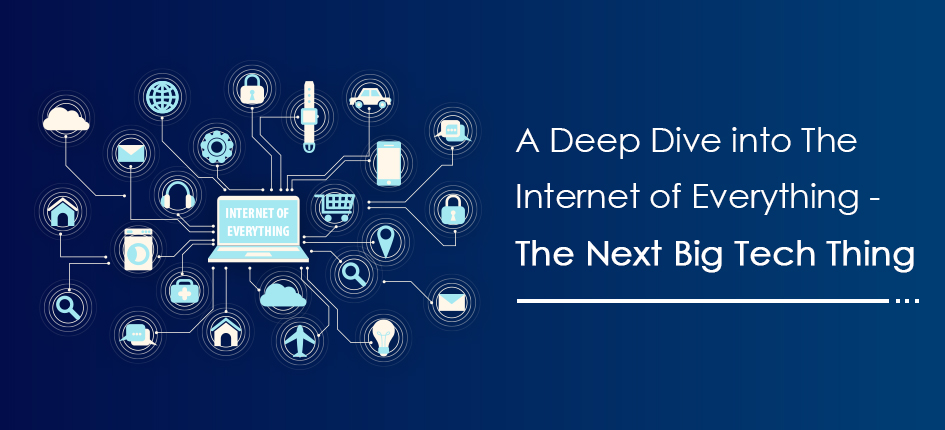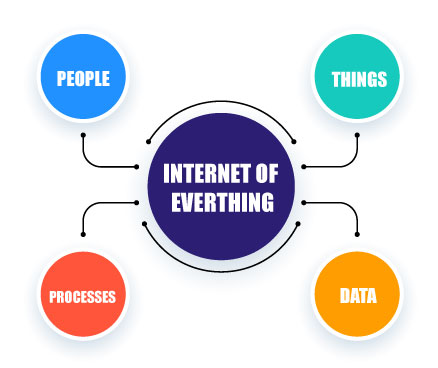A Deep Dive into the Internet of Everything – The Next Big Tech Thing

The advancement in the global web has prompted all-around penetration of virtual connections in real-world objects and activities. Currently, everything can be connected with everything, building a new distributed network that goes beyond the known “Internet of Things” concept. To describe this dynamically changing phenomenon comprehensively, Cisco coined a term – Internet of Everything (IoE) – a technology that has the potential to reshape the tech industry.
Let’s look at the bigger picture of IoE and how it differs from IoT.
The IoE concept is based on the notion of ubiquitous connectivity as well as intelligence. It depicts that smartphones, tablets, and computers do not hinder smart internet connections. Any object can be integrated with digital features and easily connected with the distributed ecosystem of other objects, people, and processes. Thus, the generation and exchange of valuable data and the decision-making process become easier than ever.
What is IoE?
In simple terms, the Internet of Everything is the connection between objects, people, processes, and data merged into a common interrelated network. It aims to improve experiences, make smarter decisions, and deliver value.
Furthermore, IoE represents the world in which a myriad of sensors are incorporated into a myriad of devices, equipment, and ordinary objects, thus providing them expanded networking opportunities and making them smarter.
In businesses, individuals, and governments, the chief purpose of the Internet of Everything is to convert gathered data into actions, facilitate futuristic, data-based decision-making, and offer new capabilities as well as experiences.
Constituent Elements of IoE
Hardware, software, and devices are deemed the critical components of the IoE sphere. However, there are four constituent elements of this technology that make networked connections more relevant and valuable.

People
People use connected devices to deliver insights related to their personal or professional self. This data may include their preferences, interests, personal health, etc. which is analyzed by AI algorithms and other smart technologies to further provide relevant insights that enable them to solve issues and make decisions quickly.
Processes
Different processes like AI, machine learning, or other technologies ensure the delivery of accurate data to the right person or machine at the right time. Since this data is more about insightful information and actions, finding a way to decipher the proper flow of data is the key to leveraging the big data. Precisely, the primary purpose of processes is to make the best use of Big Data.
Data
The data generated by devices is nothing, but once it is combined with analytics and analyzed accurately, it turns into a valuable data that can control various systems, empower smart solutions, and help businesses manage the organization.
Things
Here we come across the IoT concept. Internet of Things is the interconnectivity of various physical items embedded with sensors and actuators. These devices generate data on their status and transfer it to the required destinations across the network.
Internet of Everything vs. Internet of Things
To steer clear of the confusion between IoT and IoE, let’s figure how these terms differ from each other.
The main difference between IoE and IoT is the key components of these terms.
- IoT connects physical devices only.
- IoE covers four elements, including people, processes, data, and things.
Basically, IoT is the interconnectivity of physical devices that transfer data, while IoT is a broader concept that comprises ample technologies, people, physical devices, and end-nodes.
However, there are many similarities in both of these different terms.
Decentralization –
Networks of IoT and IoE are decentralized and don’t have a single center. Each node or device operates as a small management center and can independently perform various tasks.
Security Issues –
Since the systems of both technologies are distributed in nature, they are highly prone to penetration and cyberattacks. The number of devices is in direct proportion to the susceptibility to breaches.
On the one hand, decentralization allows the network to exchange data even though a couple of nodes malfunction. On the other hand, such distribution results in threats in the form of data security and personal privacy.
The Impact of IoE on Businesses
Internet of Everything is anticipated to reshape the businesses radically. From processes, models to business moments, IoE has the power to transform everything by providing insightful data for critical decision making.
Business Process –
The business process refers to the mechanism of performing an operation like manufacturing process, market strategy, etc. With IoE implementation, you can generate insights to navigate decision making at every step of the business. Besides, a plethora of data sources provides new types of data that can be used to turn qualitative insights into quantitative numbers. For instance, linking an employee’s outcome based on a change in the variable in the work environment.
Business Model –
The way new businesses are emerging is revolutionizing the current way of running a business. For instance, Nike’s health device has reinvented Healthcare practices. Nike is basically a sports and fitness brand. But by embracing smart technologies, it will not only penetrate but also fuel the Healthcare sector. Likewise, the smart cars of Google will transform the automobile industry.
Business Moment –
The Business moment is indispensable to race with the agility and speed in accordance with the pace of the data generation. With IoE, you can add sensors and data sources to the currently available data, which will bring forth opportunities to rapidly generate insights for your business. However, with the availability comes the complexity. Businesses will strive to leverage this data faster than their competitors, resulting in agile and quick decision making.
Examples of IoE
Practically, every industry can integrate an IoE model into its operations and yield enormous benefits. Some of the cases are:
The municipal sector can employ smart water and electricity meters to monitor consumption rates in residents and commercial organizations and make futuristic decisions related to economy and cost-cutting.
The manufacturing companies can integrate predictive maintenance sensors into production to examine the parts of machines that need to be fixed or replaced. This eliminates downtime and reduces fixing costs extensively.
Logistics and delivery business can exploit sensors and smart devices to optimize delivery conditions and routing. Eventually, organizations can boost end-user satisfaction.
Closing Thoughts
At one fell swoop, digitalization fosters the development of a myriad of smart and automated hardware pieces. With the growing range of IoE appliances, industries are inevitably disrupting.
In the foreseeable future, we are definitely going to experience the ubiquitous connectivity of everything. It won’t only help you to change the way you run a business but also enable you to provide better services and manufacture better products.
To garner in-depth knowledge of IoE or IoT, approach our experts.

